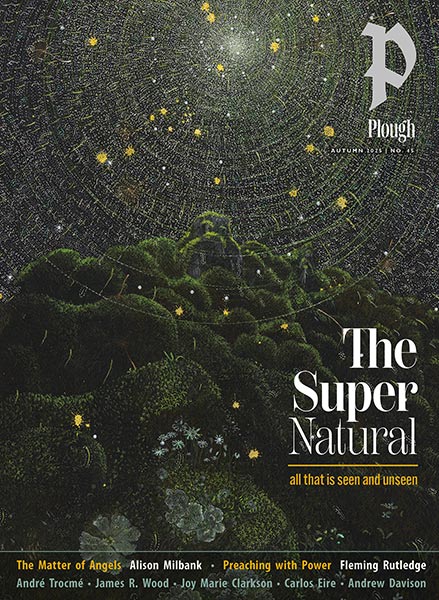Subtotal: $
Checkout-

Editors’ Picks: Dinosaurs
-

Editors’ Picks: Natality
-

The Mustard Seed Project
-

Feasting at Teatime
-

Letters from Readers
-

Covering the Cover: Money
-

Hudson Taylor
-

The Effective Samaritan: A Parable
-

The Justice Mothers Are Due
-

The Library at Home
-

Who Deserves Medical Care?
-

A Saver’s Grace
-

Light Came in as a Flood
-

The Other Side of the Needle’s Eye
-

Selling Friends
-

Princess of the Vatican
-

Enchanted Capitalism
-

Leper Colony Sketches
-

In Praise of Costly Magnificence
-

The Last of the Cuban Revolutionaries
-

The Religion of Mammon
-

Pay As You Can
-

Ownership and Communion
-

Saving the Commons
-

History Arrives on the Island
-

On Owning Twenty-Two Cars
-

Where Your Treasure Is
-

Poem: “Clair de lune”
-

Poem: “Argument of Periapsis”
-

Poem: “Advent”

Editors’ Picks: Thin Places
The Ireland of Kerri ní Dochartaigh’s Thin Places offers more than a token sense of generic mysticism.
By Allison Backous Troy
July 25, 2023
Next Article:
Explore Other Articles:
A “thin place,” according to Kerri ní Dochartaigh, is explicitly Irish. It is a place where the curtain between what is known and unknown loosens, unfolds, and for a moment, disappears. Thin places are liminal, surprising, sacred, just as common in parking lots as in forests, “brimming with something like renewal.” Many know this Celtic understanding as a way of seeing a beautiful, mystical order in the world, and ní Dochartaigh obliges: she follows birds on coastlines, watches moths take flight, and listens as Ireland’s habitats “sing of all that came and left, of all that is still here and all that is yet to come.”
But for ní Dochartaigh, her native Ireland offers more than a token sense of generic mysticism. Ireland – and in particular, her childhood home of Derry – is a world made alive by violence, and especially the sectarian violence of her childhood that added more scars to Ireland’s psyche and landscape. The conflict between Catholics and Protestants turned ní Dochartaigh’s hometown into a place often made thin by gunshots in the streets. Ní Dochartaigh’s own home was bombed when she was eleven, and the constant suspicion of locals toward her parents (one Catholic, one Protestant) meant that she spent her childhood in flight, her family constantly looking for safety as they fled housing complex after housing complex, teenage boys staring malevolently into their yard.
But ní Dochartaigh’s book is more than a scrapbook of the violence that punctuated her early years. It is a pilgrimage through her inner and outer landscapes, along the River Foyle, the waterway that gave troubled Ireland its own liminal boundary, whose slippery surface sat nearby wherever she lived. She leaves Ireland as an adult, but what doesn’t leave her is the pain, her body having kept score of the traumas of a broken family in a broken country. “Witnessing violence of the kind we did,” she writes, “so often, so intimately, to such a destructive end – does something to you … you have too much weight around your neck.”
Readers will need to be aware that much of this book chronicles ní Dochartaigh’s reckoning with suicidal ideation and alcoholism. It is her honest reckoning with what she carries as a child of civil war. She also carries talismans of the natural world: rocks from the Foyle’s banks, bird feathers, pebbles smoothed by water and wind.
Ní Dochartaigh returns to Ireland to keen, to wail, and to mourn; in doing so, she hears “a call back to the land that made me, that wounded and broke me, the land that turned out to be the only place that held the power for me to heal.” It is this return, and her record of it, that could help us cross our own thresholds, or at least find room to “imagine what lies beyond the here and now.”
Already a subscriber? Sign in
Try 3 months of unlimited access. Start your FREE TRIAL today. Cancel anytime.









































Christine
I used to lead a publication called "Thin Space," borne of this idea. Find us @thin.space on Instagram, if you're interested.
Andrew Churney
What shocks me is that a war exists between 2 groups claiming to be "Christian!" If there is anything that does not typify Jesus, it is violence of this sort! How far away from Truth can people drift? Very far indeed! So far, that a culture lives in anti-truth, and doesn't even realize it...